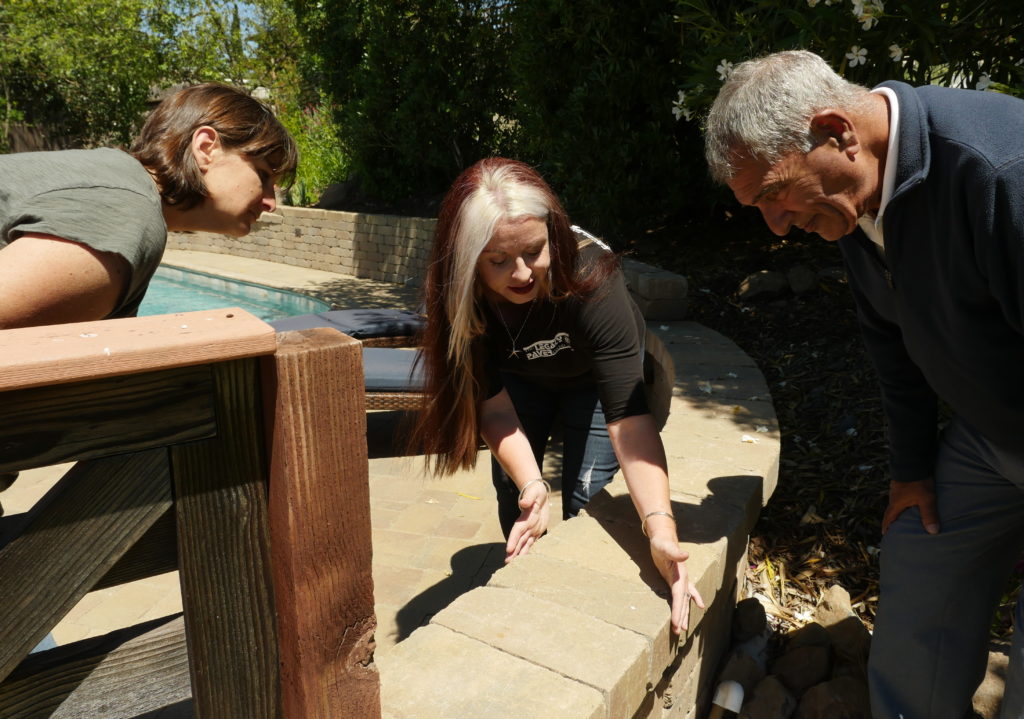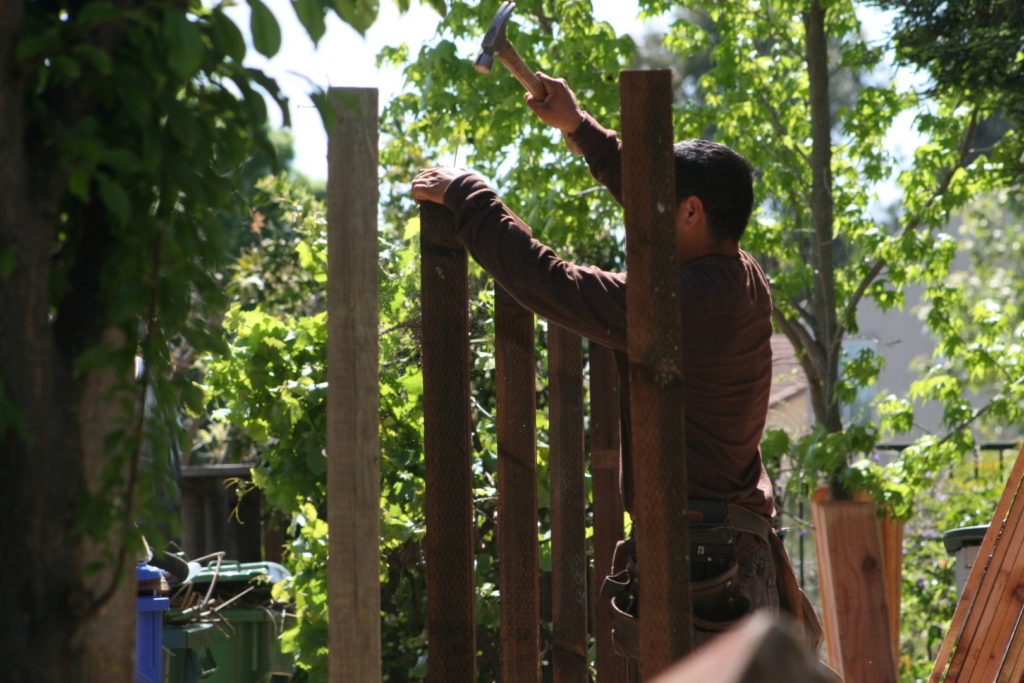
Whether or not it crosses the property line, you’ll want to avoid neighbor conflicts during a home maintenance or improvement project. Photo: The Legacy Paver Group ©2019
Neighbors are kind of like family—whether or not you get along, you’re pretty much stuck with them. One thing that can impact your relationship with your neighbors is home maintenance or improvement projects, especially if a shared property line is involved. To avoid potential conflicts (and know what to do when conflict arises), we asked a few professionals for their advice on navigating this often-complex dynamic. Here’s what they recommend:
Communicate proactively.
When having work done on your home or yard, you may not see any reason to let your neighbors know about it. However, even if it’s taking place on your side of the property line, the work can still impact your neighbors and lead to conflict. To prevent this, Haley Johnson, owner of The Legacy Paver Group, recommends communicating proactively. “Dust and noise are common byproducts of a home or landscaping project,” she says. “Instead of hoping your neighbors don’t complain, it’s better to notify them of the project in advance. That way, they’ll be anticipating the situation rather than having it unexpectedly sprung on them.”
Proactive communication is even more important when it comes to projects that cross property lines, such as fence repairs or replacement. “With a fence project, your first step should be to approach your neighbor and discuss how you want to go about it,” says Ona Hennessey, owner of Hennessey’s Construction and Fence. “That way, you can get an understanding of each other’s circumstances. Maybe your neighbor has a tight budget and needs a payment plan, or maybe they want to see about getting repairs instead of a full replacement. These sorts of things can be negotiated, but it all starts with good communication.”
Be considerate.
While neighbor conflicts can arise due to large projects, they can also stem from subtler circumstances, such as a lack of maintenance. For example, a tree that borders a property line can cause issues if it’s not maintained. That’s why Gary Gilliam, owner of Artisan Tree Trimmers, recommends being considerate, regardless of which side of the line you’re on. “When it comes to tree maintenance, there’s the law and there’s what’s polite,” he explains. “The law says you have a right to cut whatever crosses your property line, including overhanging branches and encroaching roots. However, you don’t have a right to damage the tree, which is why you have to be careful when pruning or hiring a company to do it for you. Of course, the polite thing is for the owner of the tree to trim both sides.” Learn more about California’s laws regarding trees and property lines.

Fence replacement is one project where neighbors don’t have any choice but to work together. Photo: Hennessey’s Construction and Fence ©2019
Be willing to compromise—just not on quality.
When it comes to a building project that crosses property lines, even if you and your neighbor agree to share the cost, you may disagree about particulars like aesthetics, materials or which company to hire for the job. In such cases, Ms. Hennessey recommends maintaining a willingness to compromise. “For example, maybe you want lattice on your fence but your neighbor doesn’t want to pay extra for it. If you’re willing to pay the difference, your fence contractor can bill you separately for that portion of the job. That way, everyone gets what they want.”
However, while it’s good to compromise on non-essential aspects, one thing you shouldn’t compromise on is quality. After all, you don’t want to pay twice to have your fence redone because your neighbor wanted to go the cheaper route. “I can recall an instance where a client wanted to hire us to replace their fence, but the neighbor wanted to have a landscaper or handyman do it instead,” recalls Ms. Hennessey. “A couple of years later, the client called us back to have us redo the fence because it was failing already. The neighbor was trying to save money, but they ended up spending more because it wasn’t done right the first time.”
If your neighbor wants to go with cheap labor and materials, you’ll need to convince them why it’s more cost-effective to invest in quality. Compare your contractor’s bid with theirs and point out crucial differences in the details. Remember, a contractor’s bid should give a thorough breakdown of the costs involved—this helps ensure accuracy with the final price. You can also compare each company’s reviews, certifications and industry affiliations. You can even ask your contractor to write your neighbor a letter explaining why they would be the better choice.
Make sure expectations are clear (and the contract is signed).
Even if you and your neighbor have discussed the details of your shared project, don’t assume you’re on the same page—especially when it comes to signing a contract. “It’s really important that everyone has the same expectations and signs the contract before the work is done,” affirms Ms. Hennessey. “We recently had a situation where a client signed for a fence project under the assumption that their neighbor would reimburse them for their share. Come to find out, the neighbor didn’t want to pay because it wasn’t what she expected. She wanted the fence to have lattice but the client ordered something else.”
To avoid these kinds of predicaments, Ms. Hennessey recommends having a separate contract for each party. That way, the work can’t begin until everyone has signed.
If necessary, get input from an expert.
If you’re getting resistance from a neighbor about pursuing a shared project, a professional’s perspective may help convince them. For example, if there’s a disagreement about mending a shared fence, Ms. Hennessey suggests having a fence contractor perform an assessment. “After the assessment, the contractor can write a report explaining the state of the fence and why it needs to be repaired or replaced. You can use this report to negotiate with your neighbor and hopefully avoid a legal situation.”
Be diligent when taking legal steps.
Unfortunately, there are some situations where one neighbor’s unwillingness to cooperate requires the other to take legal action, especially if there are safety or security risks involved. For example, a failing fence can pose a substantial safety concern if you have small children or pets. The good news is, thanks to California’s Good Neighbor Fence Act of 2013, you have the legal means to do something about it.
According to Ms. Hennessey, what you would do in this situation is pay for the fence project yourself and then take your neighbor to small claims court afterward to recoup their portion of the bill. However, she emphasizes the importance of following the proper procedure. “First, you’ll need to get multiple contractor bids and choose one that’s somewhere in the middle,” she explains. “You can’t take the highest quote and expect your neighbor to pay half of it—it has to be reasonable. You also need to give your neighbor a 30-day notice for the fence project. This is very important if you want to have a case in small claims court. Send a notice via certified mail that lets them know the fence is going to be replaced on a specific date—just make sure the date is at least 30 days away.”
In other cases, a neglected item on your neighbor’s property might pose a safety risk to yours—for example, a dead or dying tree that you’re afraid might fall on your house. Fortunately, even if it’s not technically on your property, Mr. Gilliam says you have legal options. “In a situation like this, you would take the matter to court. Hire a certified arborist to assess the tree and write an arborist’s report. This will serve as official evidence for your claim.”
Hire a contractor that will communicate on your behalf.
If you have reservations about interacting with neighbors regarding a home improvement project, don’t underestimate the value of a contractor that’s willing to communicate on your behalf. “When a client is concerned about issues with a neighbor, we’ll go knock on their door, introduce ourselves and tell them what we’re doing,” says Ms. Johnson. “We let them know what to expect in terms of noise and dust, and we give them our phone number so they can contact us directly if they have any issues. That way, if there’s any conflict, it’ll bounce back to us instead of our client.”
When it comes to shared projects like fence replacement, you’ll want a contractor that can communicate on your behalf and also mediate disagreements. “As a fence contractor, we know it can be difficult to work things out between neighbors, which is why we’re willing to help,” says Ms. Hennessey. “We can meet with neighbors, break down cost estimates and explain why, for example, replacement is more cost-effective than repairs. When neighbors aren’t on speaking terms, we’re happy to act as the middleman and facilitate the separate contracts. That way, the work can get done and the process can go as smoothly as possible.”
Keep in mind that not every contractor is willing to communicate and/or mediate on their clients’ behalf, so it’s a trait you should consider when making your hiring choice.
To find a Diamond Certified fence contractor, paver contractor or tree service company in your area, visit www.diamondcertified.com.
One Response
Leave a Reply
You must be logged in to post a comment.

It’s always a good idea to hire a professional surveyor to mark property lines ahead of time, and a quality fence contractor with good references. This will save you a lot of headaches!